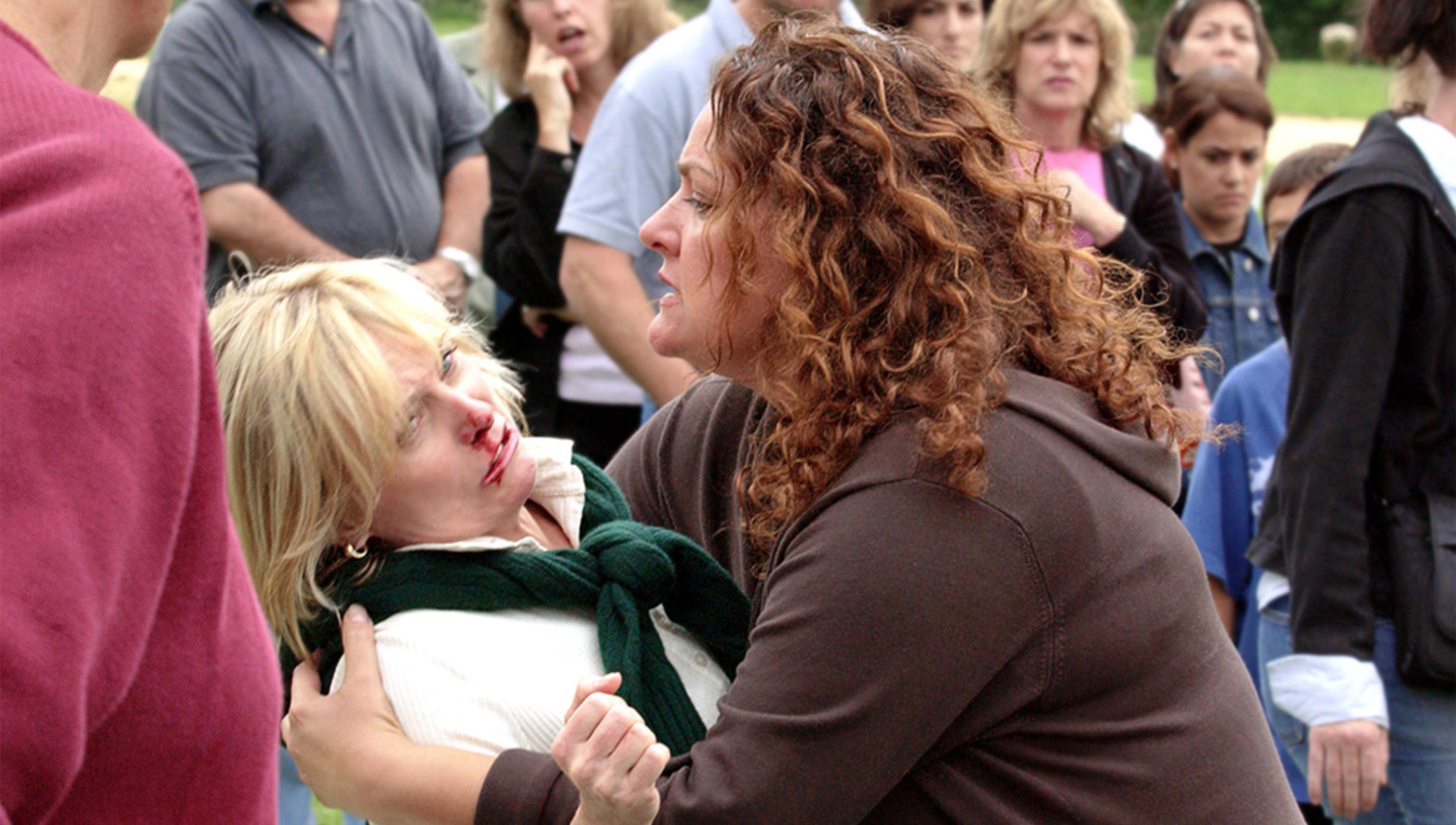From shifty eyes to fidgeting fingers, there are many folk beliefs about the signs of lying – but what does the science say?
Across time and cultures, many claims have been made about our supposed ability to detect the lies of others. Sigmund Freud wrote: ‘He that has eyes to see and ears to hear may convince himself that no mortal can keep a secret. If his lips are silent, he chatters with his fingertips; betrayal oozes out of him at every pore.’ According to a Hindu text dating to 900 BCE, a person who is lying will run the great toe along the ground and shiver, and rub the root of their hair with their fingers.
More recently, in the US TV series Lie to Me, the fictional psychologist Cal Lightman busted liars by interpreting their facial expressions. In real life today, in return for a fee, there are plenty of consultancies that offer to train you to hone your competence in lie detection. Of course, sites like YouTube boast countless lie-detection tutorials. And you and your friends and family might well have your own hunches about how to spot lying. But there’s no need to rely on intuition – a huge research effort in psychological science has tested all these long-running speculations and claims empirically.
Indeed, the study of lying is at least a century old, and thousands of scientific papers have been published. Researchers have mainly focused on the two key questions raised by that quote from Freud and the anecdote from India, namely: how good is the average person at detecting lies; and what, if any, are the behavioural signs of lying?
To answer the first question, researchers have typically shown participants video clips of people telling a story. In some studies, the videos are from real life, in other studies they are artificial, but in all cases the researcher knows which ones show someone telling the truth and which show someone lying, and the job of the research participants is to decide for each clip whether the person is lying or not.
For instance, in a classic study from 1991, the psychologists Paul Ekman and Maureen O’Sullivan showed participants clips of young nursing students watching a video (which was out of view to the participants) while describing it out loud as positive, and describing their current emotional state as calm and relaxed. In reality, while half of the students viewed a movie of beautiful pastoral landscapes, the other half actually watched a gruesome and upsetting video – so their accompanying description was a lie. To boost the students’ motivation, Ekman and O’Sullivan told them that an ability to hide their true feelings was a good predictor of success in nursing – probably not entirely untrue. Meanwhile, the research participants in the study, who had to judge which students were lying and which were truthful, were professional fact-finders – court judges, psychiatrists, criminal investigators. Despite their professional expertise, the participants were unable to distinguish which nursing students were telling the truth about their state of mind, and which were faking it – scoring either no better, or barely any better, than if they’d guessed at random.
So, the argument goes, when there is lots at stake, lying might be harder to conceal, and signs of deceit might leak into the liar’s behaviour
If people whose job involves the detection of deceit weren’t competent on such a task, is there any reason to expect ordinary citizens to be so? As it turns out, we are not. The general findings of this classic study have been confirmed by a large number of laboratory studies with laypersons and professional fact-finders as participants, all pointing to the same conclusion: on average, people are not able to tell lies from truths based on how others talk or behave.
Critics of this field of research have argued that you can’t extrapolate from such studies to real life because, in the scientific laboratory, experimental confederates (like the nursing students) are instructed to lie, and whether or not they are believed has no discernible consequences for them, whereas in contexts outside the lab, the liar’s future might depend upon their ability to dissemble convincingly. So, the argument goes, when there is lots at stake, lying might be harder to conceal, and signs of deceit might leak into the liar’s behaviour.
But think about it: how often do you detect lies by other people and how often are your own lies uncovered? Not only the small white lies that grease the wheels of social interaction, but also the more serious lies that, if revealed, could turn your life upside down, be it in the professional or personal sphere. We suggest that such deceits are rarely discovered (unless the liar confesses), and the available research confirms our belief.
Researchers have been creative in recruiting real-life scenarios for conducting deception research. They have selected situations where it is important to be believed – for example, in interactions with police. Yet when research participants watch videos of suspects denying they were hiding anything from an officer, they still perform barely above chance in distinguishing liars from truth-tellers. Another line of research has taken advantage of the fact that, when children or young people are reported missing and the police have no good leads, they sometimes ask a close relative to take part in an appeal on TV, to implore the perpetrator to release the child. Occasionally, it later transpires that the mourning relative was in fact the perpetrator. Once again, however, when naive and professional participants watched archival recordings of innocent and guilty mourning relatives, and attempted to judge who was being truthful and who was not, they performed no better than if they were guessing at random.
So, despite the fact that cultures throughout history have had quite firm ideas about how an untruthful person behaves, the science suggests people are generally poor at detecting lies. What’s more, it’s not as if the average finding is misleading – the evidence shows that differences between people in their lie-detection ability are strikingly small. Earlier claims that certain specific groups of people – such as the anxiously attached, or psychopaths – are naturally expert lie-detectors have turned out to be statistically flawed.
Overall, liars don’t appear nervous, and they don’t avoid eye contact, any more than those telling the truth
Why should it be that people struggle to tell who’s lying? There are two possible explanations: perhaps there are no reliable behavioural signs of lying and deceit; or maybe there are reliable signs of deceit, but we are simply not aware of them or able to act on them.
In modern times, psychological folklore across the world tells us that lying is reflected in signs such as bodily unrest, nervousness and gaze avoidance. Are such ideas correct? Do lies and deceptive behaviour systematically leak into the liar’s behaviour? Simply put, the answer is ‘no’. Analyses of liars’ behaviour, in the kind of research we’ve described, have shown that, overall, liars behave no differently from people who speak the truth – and this is the case in everyday situations, in laboratory studies and in real-life contexts where their very freedom might be at stake. That is, when researchers aggregate many observations across multiple studies, liars don’t appear nervous, and they don’t avoid eye contact, any more than those telling the truth. They do make fewer body movements than truth-tellers, but the tiny, tiny size of this effect means that there is no way to exploit it in practice.
In a comprehensive and classic review of the literature 20 years ago, Bella DePaulo and her collaborators concluded that the ‘looks and sounds of deceit are faint’. In their more recent review of the literature, Aldert Vrij and colleagues seconded that conclusion, and added that ‘people are mediocre lie catchers when they pay attention to behaviour’. An idea that has been explored recently is whether we can somehow pick up lies unconsciously (detecting the behavioural signs without realising it), yet here too the evidence is at best equivocal, and nowhere near being practically applicable.
One possibility, of course, is that the supposed signs of deceit are so well known that most liars simply choose to avoid such behaviours, for instance by deciding to look straight into the eyes of their interlocutor as they speak. This has led some to ask whether there might be behavioural signs that are not easily controlled, and that could give away a lie in a manner that would be detectable by technology or highly trained experts? A candidate for such a subtle, sophisticated, revealing cue is the so-called ‘micro-expression’ – a small and very rapid muscular contraction of the face elicited by a person’s emotions. Popularised by the Lie to Me TV series, these movements are almost undetectable by naive observers. Yet the available research is sobering to fans of the idea that micro-expressions can be used as ‘tells’. Studies using careful analysis of facial muscle movements frame by frame in videos show that people in fact produce very few micro-expressions and, what is more, they don’t appear to arise more frequently when a person is lying.
So, how best to detect a lie? Well, there is one reliable procedure based on common sense, and that is to simply find out what the supposed liar says that does not fit with other stuff that you know. This is a recommended strategy for police interviews and, after a century of research, the only one to disclose lying in everyday contexts. A suspect should initially be asked to give as complete an account as they can of the alleged incident, together with their alibi or reason for their denial. In such a set-up, because they don’t know what evidence the authorities have, an interviewee can inadvertently produce a narrative that is inconsistent with other relevant and reliable information, thereby in many cases trapping themselves in a lie.
Despite the abundant scientific evidence showing there is no metaphorical blue light that flashes when a person lies, popular belief in the viability of lie detection goes back centuries and seems unlikely to disappear any time soon. Many contemporary leisure activities depend on us not being able to detect lying, yet believing that we can (or that we can at least try): card games such as poker or cheat, or the long-running BBC TV gameshow Would I Lie to You?
In any case, the story from the psychology of lie detection is two-fold: unfortunately, inveterate liars – like the character George Costanza in the US sitcom Seinfeld or some politicians – are always likely to get away with it to a certain degree; but on the other hand, at least you can save yourself time and money, and skip those YouTube videos and consultancy courses that promise to teach you how to detect lies.



